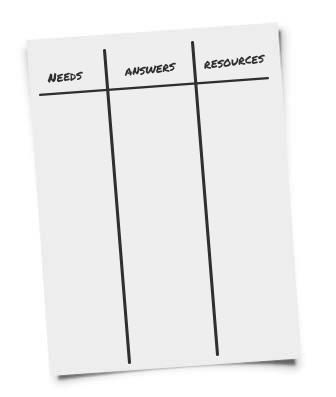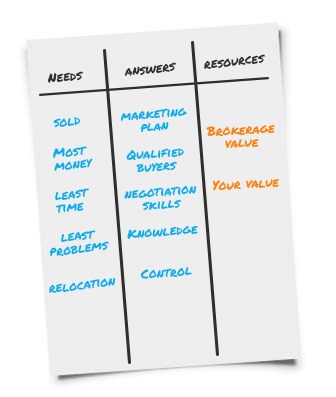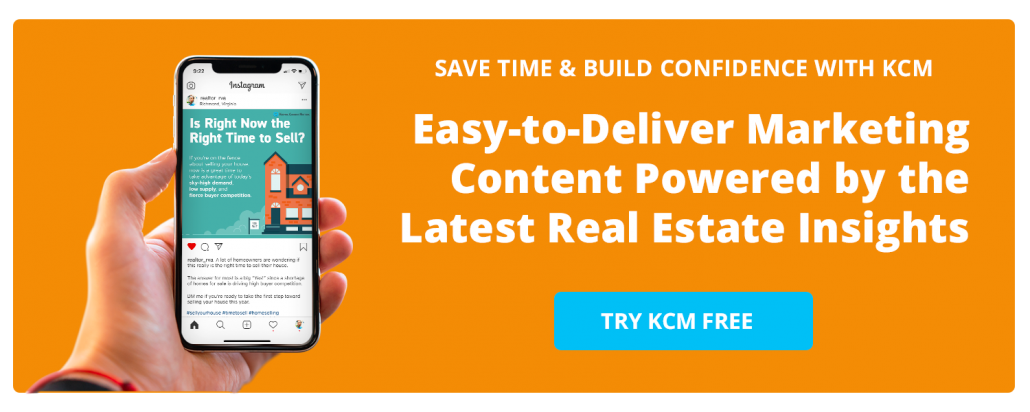13 Minute Read Time
The real estate world has changed dramatically in the past few years. While clients used to work with the biggest and most well-known companies based on their brand and advertising campaigns alone, today’s consumers want much more than a compelling commercial. They want to buy into something they can trust.
But trust is earned. And with increased competition and nonstop marketing noise, agents need an ace up their sleeve to stand out. That ace is a perfect listing presentation.
Why a Perfect Listing Presentation is Important: Sellers Must Trust You To Do Four Things
We all know that a listing presentation is a pitch that agents give to a prospective client who is looking to sell their house. But there’s more to it. The seller must trust you to:
It’s not enough to just simply have a listing presentation. You need a perfect listing presentation that accomplishes all of the above AND gets you the listing.
In this guide, we discuss the five elements that make up a ‘perfect’ listing presentation, and show you how to use it to separate yourself from your competition by proving that you can be a ‘trusted advisor’ to the seller.
YOU HAVE TO BUILD TRUST WITH THEM SO THEY CAN BE CERTAIN YOU’RE THE BEST PERSON TO HELP THEM REACH THEIR GOALS.
Think of it like owning a shoe store. If you knew there were people already lined up around the corner and busloads of people coming, you’d make sure you had every single size, in every single color, and every single style in stock. Likewise, when a buyer contacts you on the web, comes into your office or calls you from a sign you have posted, you want to have plenty of inventory so you can meet their needs.
Today, more and more sellers are stepping back, taking a look at the advice real estate professionals give them, and asking themselves whether they can trust that advice. Therefore, when you’re at a listing presentation, the most important element is whether you can build trust with the homeowner.
Your sellers must know that you have their best interest in mind, and that you’re going to be able to help them accomplish their goals. To do that, you must first make sure you understand what those goals actually are.
5 Steps to Making the Perfect Listing Presentation
Step 1: Build Rapport
Just as in any other presentation, your listing presentation needs to start strong and end strong.
The beginning and the end are the most important parts. But the beginning isn’t when you start talking; it’s the moment you walk in the door, before you say a word. Sellers are not going to trust you until they like you. To get them to like you, you must make sure they understand that you care about them. So make sure their first impression of you is a positive one, even if you’re giving a virtual listing presentation.
Smile, show genuine interest in them and their needs, and look professional. Those first few moments of your meeting, before the actual presentation begins, will set the stage for rapport building. Once you start the actual presentation, add enthusiasm to your voice and facial expressions.
THEY WANT TO MAKE THE RIGHT DECISION FOR THEMSELVES AND THEIR FAMILY, AND THEY’RE LOOKING TO YOU FOR YOUR EXPERT GUIDANCE.
Being boring will make it extremely difficult for you to build rapport. The seller will be nervous. They may be moving their children to another school. There may be medical issues that caused the move. They might need as much money out of the sale of the house as they possibly can get. They want to make the right decision for themselves and their family, and they’re looking to you for your expert guidance.
Unfortunately, there are still many agents who start the presentation by bragging about their company or themselves. But that’s not what’s important to the homeowner—at least not up front. What’s important to the homeowner is that they know you care about them, not how much you care about yourself or your company.
Step 2: Identify the Seller’s Needs
You need to prove to the seller’s that you’re there to make sure they’re okay. How can you do that?
 You want to know what their needs are right from the beginning. That’s the only way to make sure you can help them reach their goals. They want to make sure you’re listening, and that you’ll be able to help them.
You want to know what their needs are right from the beginning. That’s the only way to make sure you can help them reach their goals. They want to make sure you’re listening, and that you’ll be able to help them.
So, before you start doing anything, pull out a blank piece of paper and break it down into these three categories. See the image on the right for reference.
You do this because:
-
They’ll know you care about them right out of the gate because you’re asking what they need.
-
They know you’re the person they can trust because you’ve demonstrated value.
Some agents argue that a pre-scripted presentation manual allows them to keep better control of the appointment.
However, in reality, the person doing the talking is never in control. The person asking the questions is always in control. If you don’t believe this, think about a courtroom.
Who’s in control: the attorney or the person on the witness stand? The attorney, of course, because he or she is directing the conversation by asking questions.
You may ask, “What if they say something I’m not prepared for?”
First, let us say that the chance of that happening is very slim. In fact, there are five things that a seller will potentially tell you when you ask them what they need from the sale of their home.
They are:
These are the five things every single seller is going to tell you, and it’s been the same five things for the last 30 years. The potential for someone saying anything different is extremely low, so don’t worry about them saying something you’re not prepared for.
As you can see, the first step in building rapport is pretty simple: start with caring about them. Start with talking about them. Start by asking them what’s important to them. They will begin to like you and you’ll begin the process of getting them to feel that they can trust you.
THESE ARE THE FIVE THINGS EVERY SINGLE SELLER IS GOING TO TELL YOU, AND IT’S BEEN THAT WAY FOR THE LAST 30 YEARS.

Now that you know what they need from the sale of the house, you need to teach them the answers that will fulfill these needs—the staple things they need to accomplish their goals.
If they want the house sold for the most money, in the least amount of time, and without hassles, what is necessary?
Write the answers on the piece of paper.
Notice that you haven’t talked about your company yet. You haven’t talked about yourself yet. Instead, you’ve discussed the generic answers to their needs. These are the things they’re going to need from your real estate company. These are the things they’re going to need from an agent.
You’ve built rapport by first asking what they need. You’ve given them the answers to their needs in a generic form without ever talking about you or your company. Now you’re in a nice conversation: two people talking about how they can help each other.
Then, and only then, should you begin to discuss the resources you and your company have to make sure you can fulfill their needs.
Step 3: Explain Your Company’s Value
What are the biggest benefits a seller gets from choosing to work with your company that they could not get from another?
Think of your answers to the questions above from the seller’s perspective. Your company’s value proposition should explain what unique benefits it delivers to the seller and why they should choose your firm over another. We admit that articulating a company’s unique value can be difficult.
Agents sometimes ask if an outside vendor could put together the perfect listing presentation for them, complete with the ideal value proposition. The answer is no. When it comes to the value proposition your company offers, you know that much better than anyone else does.
Some points to consider when explaining your company’s value:
- What are the fundamentals of your company’s marketing plan?
- How do you find and qualify prospective purchasers?
- What is your company’s ability to manage the overall process?
Every company has distinct advantages. You need to be able to simply and effectively explain your company’s unique value proposition and how it differs from your competitors’.
Step 4: Communicate Your Value
This is the time to differentiate yourself from other agents
When explaining your personal value proposition, you want to differentiate yourself from the other agents in the marketplace, including the agents from your own company that might go on that listing presentation.
Remember, having a strong beginning and a powerful ending is crucial. Gain their interest during the first couple of minutes of the presentation and then build to a real strength at the end.
What Do You Bring to the Table?
You now have successfully articulated the benef its of your company, but why should they work with YOU over another agent?
Here are some examples of things to include in your personal value proposition:
Just as you need to be able to talk about your company’s value proposition, you also need to have a value proposition of your own. Again, this can be difficult. After all, as children we were often told not to brag about ourselves.
But you’re not a child anymore, and you’re not bragging. You’re giving your sellers the information they need to make an informed decision. Your personal value proposition highlights what sets you apart from other agents and how you can best serve your seller.
Step 5: Develop Trust
Clients want an expert. Experts speak with confidence, and that’s how you build trust.
Sellers have to trust you enough to let you set the market value on possibly the largest asset their family owns. They have to trust you enough to set the time schedule for a successful liquidation of that asset. They have to trust you enough to set a fair fee to handle the liquidation of that asset. Therefore, you want to make sure they trust you enough at the conclusion of your presentation.
So, how do you get them to trust you?
Here’s the Challenge…
Whenever we become more involved in any situation, we enter a hyper-sensitive state of awareness. That is, when something becomes important to us, we become more sensitive to it.
For example, let’s say you went out to buy a car, and the reason you bought that particular car is because it was unique. Not very many people have that car. You were going to look pretty cool driving that car.
However, as soon as you pull out of the dealership and hit the road in your hot new wheels, what do you see all over the highway? THAT CAR! The dealership didn’t sell millions last night. You’re just now in a hyper-sensitive state of awareness.
This same phenomenon occurs when someone is considering a real estate transaction. Once a homeowner decides to sell their home they enter this hyper-sensitive state of awareness. They begin following housing news more closely. They watch the real estate segments on CNBC, listen for them on Bloomberg radio and read them in the Wall Street Journal. They get a good idea of the national housing news.
Here’s the Solution…
At this moment, what they really need is someone to explain how what they heard on the radio, what they saw on television, what they read in every newspaper does—or doesn’t— apply to your market. And you have to prove it to them.
It isn’t until then that you can discuss how what they’ve seen impacts their situation.
Additional Tips to Help Build the Right Listing Presentation
Now that you understand the essential steps, we can cover what other pieces are important for the perfect listing presentation.
But first, let’s take a look at a quote by financial guru, Dave Ramsey:
“When getting help with money, whether it’s insurance, real estate or investments, you should always look for someone with the heart of a teacher, not the heart of a salesman.”
In his quote, Dave Ramsey talks about our industry specifically. When you have the heart of a teacher, you’re willing to take the time in each presentation to teach. Every conversation is an educational opportunity.
You shouldn’t be trying to convince someone to sell their home (that’s what salespeople do); instead, you should be helping your sellers discover what their options are, explaining the pros and cons of each of those options, and then letting them make the decision that is best for them and their families.
That’s what a trusted advisor, with the heart of a teacher, does.
But while it’s just as important for you to be able to speak eloquently, intelligently and directly to your clients, it’s more important that you show them why you’re the best agent. Here are some tips and tricks on how to win a listing presentation so your listing presentation is successful for today’s market.
The Importance of Visual Aids
Simply “telling” your clients something isn’t enough. They need to “see” it to believe it. If you’re not using strong visuals in all your communications with clients (face-to-face meetings, emails, newsletters, etc.), then you’re not being fully heard or understood.
Using visuals enables you to explain your clients’ options in a way they can understand. This heavily researched topic has been proven time and time again.
Here are some more statistics that back it up:
Remember, your job now is to help your clients understand how the market impacts their situation. Powerful and relevant visuals give them the best opportunity to understand the complexities and nuances of the real estate market.
Your job is not done until they are fully informed, can fully understand the information, and can make the decision that is best for them and their family. This is also when you will have their trust and be seen as a true professional.
Take the time to prepare visuals for every appointment. It is vital to your success in today’s environment.
After all, what makes more sense:
Your Path to Success: How KCM Can Help
Yes, the real estate industry is changing dramatically. It’s no longer about being the biggest office or dispensing information; it’s about your ability to analyze that information so well that you can teach it to others, because that’s how you gain trust.
The agents that EMBRACE this concept are going to be the DOMINANT agents moving forward. They are the ones who will win the race!
“THERE IS A COMPETITIVE ADVANTAGE TO KNOWLEDGE, BUT VERY FEW DECISION MAKERS KNOW HOW TO HARNESS IT…YOU HAVE TO BE STRATEGIC ABOUT IT.” – MARTIN IHRIG
As you develop yourself as a great listing agent, remember to plot out these three steps along the way:
Step 1: Continually Educate Yourself
Whether you use the KCM membership that we provide or some other educational means, know what’s going on and why it’s happening. As Albert Einstein said, “Wisdom is not a product of schooling but of the life-long attempt to acquire it.”
Step 2: Communicate What You Learn
Think of it as the ability to sing versus being on iTunes. If you can sing, but deliver your message on the equivalent of 8-track tapes, no one will listen to you. If, however, you can sing and you publish your music digitally (the modern format), you’ll have a much higher likelihood of reaching your audience.
In real estate, this means making sure your listing presentations are filled with impactful, relevant information that will help your clients gain clarity from the confusion in the market.
Make your presentations overly visual and so simple that anyone—even a child—can understand what is happening in the current market. Graphs, charts, and infographics are great formats to use.
Step 3: Become a Keeping Current Matters Member
Fact: keeping current matters! You can have a tremendous understanding of key factors and wonderful visual materials to help make it easy for your sellers, but if you’re not updating these things on a consistent basis, you’re lost. Keeping Current Matters offers easy-to-share blog posts, social media graphics, videos, guides, and more to help you stand out as the go-to real estate agent.
How valuable would a physician be if he/she didn’t update his/her advice and recommendations based on the newest medical research? Don’t be caught with outdated information in your presentations and conversations. Do your homework and be on top of all the major news that will impact the current real estate market.
For most families, selling a home is one of the most important personal decisions and possibly the largest financial decision they’ll ever make. They are looking for someone they can trust—for a true professional to help them through this process.
Make sure that’s exactly who they get when you walk into their home for a listing presentation.










